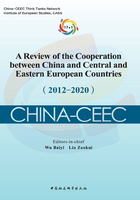
9. Outstanding Achievements from Cooperation in the Areas of Science, Technology, Education, Culture and Health
Cooperation in science, technology and innovation is an important part of China-CEEC Cooperation, where early harvest has been achieved. According to the Sofia Guidelines for China-CEEC Cooperation published in July 2018, the China-CEEC Science, Technology and Innovation Partnership will be launched, and the China-CEEC Conference on Innovation Cooperation will be held on a regular basis. A number of China-CEEC dialogues on science, technology and innovation policies have been conducted, to exchange views on science, technology and innovation policy formulation and development of national innovation system. On 8 November 2016, at the first China-CEEC Conference on Innovation Cooperation held in Nanjing, the China-CEEC Virtual Technology Transfer Center was established. Since then, four sessions of the Conference have been held in a row, to discuss possible cooperation between China and CEECs in commercialization of research findings and technology transfer. Currently, China and CEECs are working together to identify priority areas to build joint laboratories or research centers with joint integrated research, science and technology professionals exchanges and training functions, in view of their specific cooperation needs, in order to put in place a long-term and stable China-CEEC science, technology and innovation cooperation platform.
China-CEEC educational cooperation has been fruitful as well. Two mechanisms have been put in place so far, namely the China-CEEC Education Policy Dialogue and the China-CEEC Higher Education Institutions Consortium. China and CEECs have also made great headways in inter-school exchanges and cooperation, mutual recognition of diploma and degrees, exchange of students, language teaching cooperation and local cooperation. So far, China has signed cooperation agreements in the education field with 11 CEECs (Bulgaria, the Czech Republic, Latvia, Hungary, Estonia, Lithuania, Poland, Romania, Serbia, Slovakia and Slovenia), and agreements on mutual recognition of higher learning diploma and degrees with 8 CEECs (Poland, Lithuania, Latvia, Hungary, Romania, Bulgaria, the Czech Republic and Estonia). Language teaching cooperation and exchange of students have been fruitful. By the end of 2019, China and the 17 CEECs had jointly opened 37 Confucius Institutes and 45 Confucius Classrooms, with a total of over 52 thousand students. Colorful cultural and educational activities were organized and over 510 thousand people were involved. Exchanges between Chinese and CEEC schools have been robust, with 19 Chinese universities opening majors of CEEC languages, and over 10 thousand students studying in each other’s countries, significantly contributing to educational exchanges between the two sides. China-CEEC educational cooperation has entered an era of active growth, with Chinese universities opening language teaching institutes (see Table 4), joint exchange programs and CEEC-related regional and country-specific research institutes (see Table 5).
Table 4 Newly Opened Undergraduate Programs on CEEC Languages at Chinese Universities since 2012 (by the end of 2018)[7]

(continued)

Table 5 CEEC-related Regional or Country-Specific Research Institutes Established in the Recent Decade (incomplete calculation)[8]

(continued)

(continued)

(continued)

(continued)

China-CEEC cultural exchanges have been equally fruitful. The China-CEEC Ministerial Forum on Cultural Cooperation is organized once every two years. The China-CEEC Cultural Cooperation Coordination Center was officially launched in Skopje, capital of North Macedonia, in March 2018. Driven by these mechanisms, the China-CEEC Cultural and Creative Industry Forum and the China-CEEC Summer Dance Camp have become the most important cultural exchange events every year. Group visits of CEEC composers started in April 2016, and up to now, trips to Guizhou Province, Serbia, Montenegro and Sichuan Province were organized. Under the China-CEEC cultural cooperation framework, the China-CEEC Dance Culture Union, the China-CEEC Music Academy Union, the China-CEEC Library Union, the China-CEEC Arts Creation Research Center, the China-CEEC Youth Center for Arts Training and Practice, the China-CEEC Center for Cultural and Creative Industries Exchanges and Cooperation and a center for ethnic culture and arts inheritance and exchanges were established.
Health cooperation has been playing an increasingly important role in China-CEEC Cooperation in recent years. Since the first China-CEEC Health Ministers’ Forum was held in Prague, capital of the Czech Republic, in 2015, four sessions of such Forum have been organized (the last three were held in Suzhou, Budapest and Sofia respectively). The Chinese government offered 200 scholarships for CEEC medical students to study in China under its CEEC people-to-people exchanges scholarship program. Since 2016, special health funds have been set up under the Belt and Road initiative to support joint health programs. At the second China-CEEC Health Ministers’ Forum in June 2016, the China-CEEC Hospital Collaboration Alliance was launched, which has since been active in conducting exchanges and mutual visits, organizing academic activities and promoting technical exchanges and personnel training. The Forum also announced the establishment of the China-CEEC Association on the Promotion of Health Cooperation, dedicated to maintaining the sound momentum of medical and health cooperation between China and CEECs, sharing best health practice and building more health cooperation platforms.